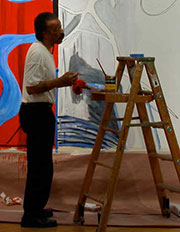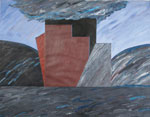Each in Their Own Voice: African-American Artists in Cleveland, 1970-2005
John L. Moore interview excerpt, 13 January 2009
Instructions for controlling the program with a keyboard.

Please note that Flash Player 10 (or higher) OR an HTML 5 compatible browser as well as JavaScript is required to play this recording. If you experience problems, please check your version of Flash or update to a more current browser and make sure JavaScript is enabled.
Program Length: 03:34
Artist John L. Moore discusses his life and art. Born on the east side of Cleveland, Ohio in 1939, Moore attended East High School and took art classes at the Cleveland Museum of Art before attending Cuyahoga Community College, and later Kent State University, where he received his Bachelor of Fine Art. The artist discusses his experiences at these institutions in some detail, including information about numerous individuals who had an impact on his artistic development.
After high school, Moore joined the Army, where he served in the 101st Airborne Division — an experience that he credits for advancing his personal and artistic development. As a non-traditional student of art, Moore also worked at Cleveland's General Motors (GM) plant to support his family and to pay for school. While employed at GM, Moore initiated an employee art program to highlight artistic works by GM employees; the program evolved into an annual judged exhibit. Moore estimates that some 10% of his co-workers at GM self-identified as artists.
The artist also discusses his teaching career, as well as the impact of Cleveland on his own art. Moore left Cleveland in 1985 to continue his career in New York City. Throughout the interview, Moore shares his observations and insights on the dynamics of race in the art world, providing detailed examples that illustrate the meaning of race in the conception, production, and consumption of artistic works by African-Americans.
This interview was recorded over a telephone connection.
Rights: Organizations and individuals seeking to use materials for public exhibition and/or commercial use must obtain permission from the History Department of Cleveland State University. Use of materials for educational and research purposes is considered fair use.






